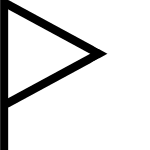Command post
Command posts are the centers for the command or command posts of military units in combat and are formed from the staffs of these units. The former name in Germany was headquarters .
Command posts are formed from battalion level upwards, and more rarely by companies. A main command post is generally set up for command and control and a rear command post for personnel and supply management. From brigade level upwards, reserve command posts must be prepared for both command posts and, whenever possible, a main command post (Res.) Or a second main command post must be set up. In most cases, parts of the main command post are also formed into a movable command post that allows the military leader to leave the command post without having to give up control. So there are usually:
- movable command post
- Main command post (from Brigade also called main command post 1)
- Main command post 2 (only from brigade)
- Main command post reserve
- Rear command post
- Rear reserve command post
Units and sub-units together with their management staff form fixed and movable management positions. According to the regulations, these are not command posts, but are colloquially referred to as company command posts, mobile company command posts and "platoon command posts", and are each connected to the radio circuit of the next higher command level.
Work and structure of command posts
The work on command posts takes place around the clock, which is why the staff is deployed in shifts . The elements of a command post are referred to as command post cells, in which parts of a command area or subject area are processed. Several cells whose tasks complement each other are referred to as control centers . A possible structure of a main command post could look like this:
- Telecommunication center (H); with head of telecommunications operations, telephone booth, teleprinter booth, radio cell, key cell
- Fire support center; with cell artillery and cell air force
- Command cell (military leader and chief of staff )
- Information center; with information cell, liaison bodies, liaison cell, rear command post, interpreter, registries
- Commander command post (H); responsible for construction and dismantling, operation and security of the command post
- Operations Center (H); with cell G2 / S2 (enemy position); Cell G3 / S3 (planning / organization); Representatives of other centers or cells (as required)
- Support cells of the Signal Corps, armored reconnaissance troop , engineering corps , Army Aviation Corps , army air defense troops , etc.
The command cell and the operations center form the core of the main command post. Rear command posts usually have an operations center (R), communications center (R), various command post cells and the command post (R). In battalions and regiments, the command posts mostly consist of operations centers.
Construction and layout of command posts
Command posts are preferably set up on the outskirts of small to medium-sized towns, which mainly consist of agricultural or industrial operations. When choosing the places where the cells and control centers of the command post are to be set up, protection against enemy reconnaissance (camouflage), the possibility of good communications connections and a sufficiently efficient network of roads and paths to and from the command post are decisive. Wherever possible, the command post is to be connected to the cable network for command work.
If possible, permanent buildings are used or, if equipped, command post work is carried out from vehicles or containers prepared for this purpose.
In order to protect command posts from attacks, they must be loosened up, camouflaged, secured and defended. The loosening up (distribution of the command post cells over a larger area) is limited by the requirement of effective cooperation within the command post as well as successful security and defense. When camouflaging, care must be taken to camouflage the approach and departure routes as well as the parking spaces for registration and visitor vehicles.
Command posts of units should be relocated every six to twelve hours, those of large units are usually relocated every 48 hours, rarely every 36 hours. In order to maintain uninterrupted command and control, the command post is usually changed on a staggered basis or through the new shift after instruction at the old location. With the reserve command post with command post containers (office container), work equipment is also available.
If a command post fails, the command must be taken over immediately by another command post. The reserve command post is usually chosen for this. If this is not possible, the command post of another subordinate troop - if possible an artillery command post - can be used for the further management of the battle.
For the accommodation of command post personnel, in particular, command posts of large formations are to be used wherever possible.
Luftwaffe command posts
Since the Luftwaffe's ground organization is largely stationary, in many cases the Luftwaffe's command posts are also built into bunker systems in peacetime. Depending on the task and importance of the command posts, they are also operated continuously in peacetime. The Air Force has a relocatable command post consisting of several containers for the command of air forces during missions abroad. For example, for the reconnaissance mission of the tornadoes over Syria, the air force command post was relocated from Fürstenfeldbruck to Incirlik / Turkey by a civil Turkish forwarding company on December 11, 2015.
Historical development
Up until the Civil War, battles took place predominantly under the eyes of the respective military leaders, who communicated the decisions they had made on the battlefield to the respective troops through adjutants , orderly officers , messengers or signals. The advice of the responsible leaders by assigned staff officers usually took place on the Feldherrnhügel, which enabled those involved to see what was happening. Only in the case of sieges or other activities that tied the armed forces to one place for a long time, the tent or the quarters of the military leader also served as an advisory and decision-making center. The steadily increasing weapon range and effect since the middle of the 19th century led to a fundamental change in tactics and thus also to the need to set up command posts. Schlieffen describes the need to set up command posts very vividly: “However large the battlefields may be, they will not reveal much to the eye. (…) No Napoleon , surrounded by a shiny retinue, stops on a hill. Even with the best binoculars, he wouldn't see much. His mold would be the easy target of innumerable batteries. The general is further back in a house with spacious office rooms, where wire and radio telegraphs, telephones and signaling devices are at hand, multitudes of cars and motorcycles, equipped for the longest journeys, awaiting orders. There, on a comfortable chair in front of a wide table, the modern Alexander has the entire battlefield on a map, from there he telephones brilliant words, and there he receives reports from the army and corps commanders, the captive balloons and the dirigible airships, which the Observe the enemy's movements along the whole line, monitor their positions. ”
During the First World War, the command posts were usually relatively far behind the front, which the victorious powers did not change until the Second World War. As early as 1921 , Seeckt demanded for the Reichswehr : “The division commander must always be in the midst of his troops. (...) To conduct the battle, the division commander goes to his command post. This should be as far ahead as possible (...). ”From this, Guderian and others developed the advanced command post with its division of tasks, which is now used worldwide with slight modifications.
literature
- HDv 100/200 command system of the army (TF / S)

